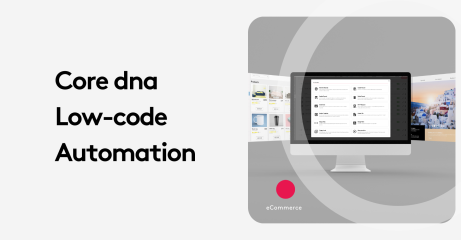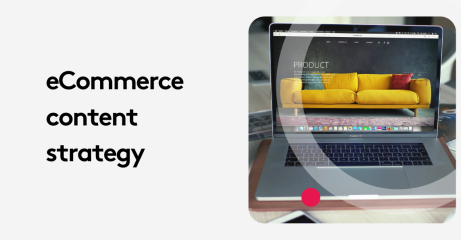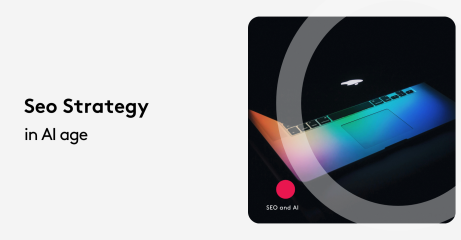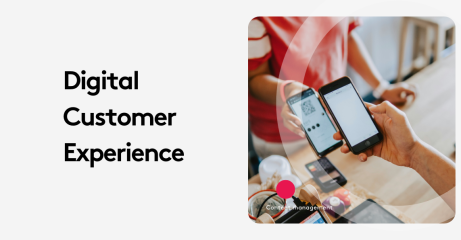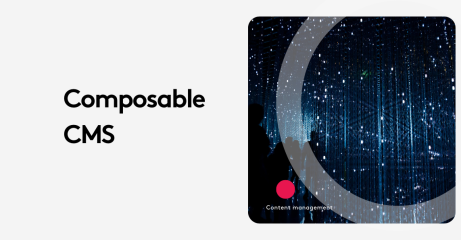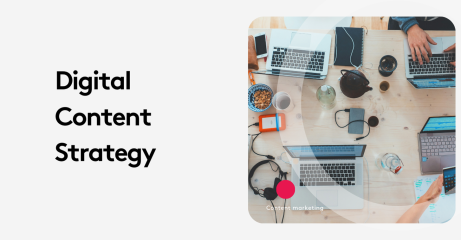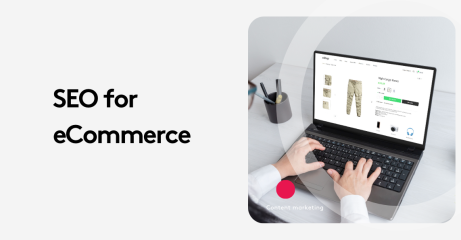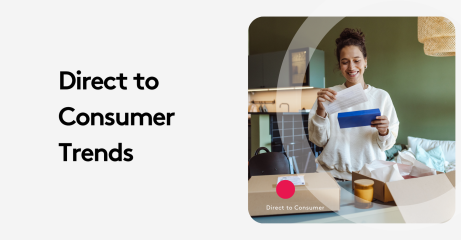Word of Mouth Marketing vs. Influencers: Who Wins?

Influencer campaigns grab headlines, but it’s everyday conversations that truly move the needle. Word of mouth marketing delivers authenticity at scale—if you know how to spark it.
How many times have you asked your friends if they have tried a product before purchasing it? Think of how often sleazy marketing techniques have fooled you.
Your customers are your best assets. They’re the ones who will provide social proof for your marketing, and they’re the ones who will vouch for the quality of our products. With that being said, if you play your cards right when it comes to customer experience, your customers can turn into your marketing team.
Having customers as part of your marketing team is extremely effective. Referrals convert at 3-5 times a higher rate than other marketing methods. They are more loyal as well. Referred customers have higher lifetime values, are more loyal and have higher margins each year that other customers.
Customers also trust their friend's recommendations over advertisements. According to Nielsen, 92% of consumers trust recommendations from friends compared to 33% trusting online ads.
Key takeaways
- Customers trust peers over ads: Word-of-mouth is powerful because people trust recommendations from friends and family far more than traditional advertising.
- Happy customers = free marketing: Delivering exceptional customer experiences encourages loyal customers to promote your brand, boosting referrals and lifetime value.
- Avoid common pitfalls: Inauthentic or unclear messages, irrelevant referrals, and incentivizing the wrong way can harm your brand’s word-of-mouth efforts.
- Leverage social proof strategies: Use tactics like influencer collaborations, user-generated content, showcasing reviews, and branded events to amplify positive buzz.
On this page:
What is word-of-mouth (and word-of-mouth marketing)?
Word-of-mouth occurs when a consumer communicates to others within their network the value a given brand has brought to their lives in some way or another.
Of course, these messages don’t have to actually be delivered verbally. Word-of-mouth (WOM) refers to any type of social proof communicated by an individual in any form, and via any channel.

Say, for example, you decide to check out the new coffee shop that just opened down the block from your house. You absolutely love their cold brew, so you bring your spouse to the shop a few days later. They also love the cold brew, as well as the atmosphere of the cafe, so they hop on their Facebook account to “check in,” alerting their closest friends of the new hot spot in town.
Fast forward a few weeks: The place is absolutely packed with friends of friends of friends of our original customer—and business is booming.
As this example shows, WOM can be a powerful way for brands to gain a ton of positive exposure in front of a highly-valuable audience.
Before we get too far ahead of ourselves, though, it’s worth pointing out that WOM can be spread organically by a brand’s audience, or it can be prompted by the brand itself.
The scenario above illustrates organic WOM in action. Here, each hypothetical customer took it upon themselves to spread the good word about the new coffee shop simply because they thoroughly enjoyed the experience—and wanted the people they care about to experience it, too.
Now, say the original customer had been spurred to tell their spouse or others about the new spot by the owner of the business, we’d have an instance of word-of-mouth marketing at hand.
It doesn’t matter if it was a simple “Be sure to tell your friends” from the cashier as they rang the customer up, or if there was a more complex offer on the table (e.g., “Tell 5 friends and get a free cup of coffee”) — if the notion to spread the good word stemmed from a prompt from the company in question, what follows isn’t technically organic WOM.
We make this distinction because the bulk of this article will be focused on WOM marketing. In other words, we’re going to assume that your overall customer experience is worth talking about in the first place — and will be focusing specifically on how to actually get your audience to start talking about it.
Though we won’t be discussing how to make your CX worth raving about (as this is an entirely different topic altogether), let’s take a moment to talk about why and how WOM typically spreads.
What drives word-of-mouth and enables it to spread?
We’ve established that WOM occurs when a consumer recognizes the value of a given brand and decides to tell others in their network all about their experiences with the company.
We should add that this simply isn’t going to happen if your customer experience doesn’t absolutely blow the customer away. Obviously, they’re not going to be rushing to tell their friends about the “so-so” experience they just had with a brand—and, if they do, their friend probably isn’t going to feel all that compelled to check the company out.
So, you need to be sure your customer experience doesn’t just meet your audience’s expectations, but rather that it completely exceeds anything they could have possibly expected.
Once you’ve met this prerequisite, there’s still no guarantee that positive WOM will start spreading “just like that.” Really, it all depends on how your audience members choose to talk about your brand.
Going back to our coffee shop scenario, it’s reasonable to believe that, had the one individual not posted about the shop on their Facebook account, her followers might not have ended up checking the spot out at all — and the place wouldn’t have been nearly as popular as it currently is.
Of course, when relying on organic WOM, your company is basically at the mercy of the customer in terms of how they choose to spread the word. While any positive exposure is good for your brand in some way, it’s in your best interest to ensure that these positive mentions of your brand are optimally amplified in order to attract the largest amount of high-quality prospects as possible.
Which is why WOM marketing is a vital part of your overall marketing playbook:
Your satisfied customers are still the ones sharing the message — you’re just giving them the platform to do it on.
Caveats and blockers of word-of-mouth marketing
Assuming that…
- You have a collection of customers willing to spread positive WOM about your brand
- Your customers have a number of channels and platforms on which to spread this WOM
...there are still a few ways these efforts could end up having no impact on your brand’s reputation. In fact, if approached in the wrong way, both your team’s and your customers’ efforts can end up doing more harm than good, overall.
Some of the most common mistakes brands make when focusing on word-of-mouth marketing include:

1. Generating inarticulate or inaccurate word-of-mouth
If a customer isn’t able to effectively communicate the incredible value your brand brought to their life, they probably won’t be able to convince others to check your brand out.
Similarly, if they make your brand out to be something it’s not (for better or worse), it’s not going to reflect well on your company.
2. Generating low-quality prospects
There’s no guarantee that all of the people who hear about a given brand through WOM will be ideal clientele for said company.
For example, even if our coffee-loving patron has 5,000 Facebook friends, the only ones who would be impacted by her recommendation are those who love coffee and live in their geographic area.
3. Generating positive word-of-mouth for the wrong reasons
While it’s not uncommon for brands to incentivize customers to provide WOM, it’s also not uncommon for consumers to spread WOM just to receive said incentive.
There’s a fine line between “nudging” a satisfied customer to put in a good word for your brand, and straight-up buying them off — and the modern consumer can easily spot the difference.
Keep these pitfalls and caveats in mind, as we’ll revisit them a few times throughout the rest of this guide.
The importance of customer retention
It is more expensive to take a customer through the entire customer acquisition and sales funnel process than it is to keep loyal customers.
“Acquiring a new customer is between 5 to 25 times more expensive than retaining an existing one.”
Loyal customers also will spend more money and have a longer life cycle than brand new customers. Therefore, focusing in on customer retention is a great investment of your time and money.
Repeat customers require less advertising to get them back to your store. It may be as simple as sending an email and they will be enticed to come back for their favorite products.
Remember, loyal customers already know, like and trust you. They don’t have to be convinced of your product’s quality.
According to research by Frederick Reichheld of Bain and Company, increasing customer retention rates by 5% has the potential to increase profits by 25% to 95%.
Once customers have experience with your brand and become loyal, they will often advocate for you. They will start to share their customer journey with their friends and family.
5 effective ways to implement word-of-mouth marketing
With all of the above in mind, let’s now go over some of the most effective ways to initiate the spread of word-of-mouth about your brand, including:
- Influencer marketing
- Hashtagged user-generated content
- Promotion of existing social proof
- Supporting an important cause
- Hosting branded promotions, giveaways, and other events
As we discuss each of these tactics, we’ll:
- Explain what the tactic entails
- Talk about why the tactic is so effective
- Provide examples of majorly-successful companies “doing it right”
Let’s dive in.
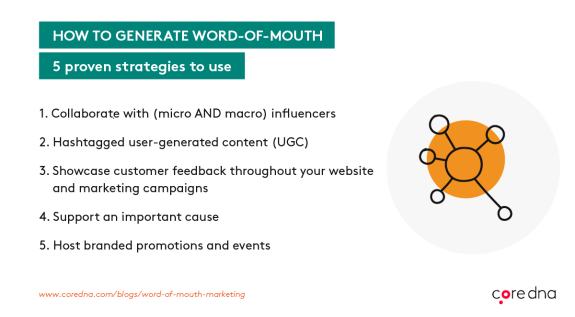
1. Collaborate with (micro AND macro) influencers
Though influencer marketing is no longer the newest trend in the eCommerce marketing realm nowadays, that doesn’t mean it’s any less effective than it was a few years ago.
(In fact, we talked this past April about our experiences using influencer marketing to help two eCommerce startups increase their clickthrough rates by 6%.)
But it’s not just our clients who are still implementing influencer marketing to great success. Data collected by 99Firms shows that:
- Searches for “influencer marketing” have increased 1,500% over the last three years
- 63% of brands plan to increase their marketing budget in the years to come
- The niche as a whole will become a $10 billion industry by 2020
The modern consumer typically recognizes influencer marketing for what it is. In other words, they know that influencers are paid or otherwise compensated for creating content featuring a certain brand.
But the nature of influencer marketing isn’t necessarily a deal-breaker to today’s consumers. As shown in the graphic below, the effectiveness of an influencer marketing campaign depends heavily on how much the consumer trusts the influencer in question.

Which brings us to why influencer marketing is so effective in the first place:
Influencer marketing is built on the two-step model of informational flow, which theorizes that information stemming from a single, centralized source (i.e., medium) will be better received by individuals when communicated via a trusted “opinion leader”:

(Why word of mouth marketing is so effective: A two-step flow model | Source)
Notice, that the “final” audience is made up of “individuals in social contact with an opinion leader.”
This is a vital part of influencer marketing:
The influencer must have forged, on some level, an authentic relationship with its audience in order for the campaign to successfully spread positive WOM.
This doesn’t necessarily mean the influencer has to know and speak to each individual person in their audience. It means that their influencer marketing content must fall in line with everything else surrounding their relationship with their audience.
For example, Kendall Jenner’s audience undoubtedly trusts her recommendations when it comes to things like fashion and accessories:
But her out-of-place (and out-of-touch) appearance in a 2017 Pepsi commercial completely fell flat in terms of generating a positive buzz. While there were many reasons the Pepsi campaign failed, there’s no denying the role its inauthenticity played in the whole ordeal.
Side note: For more on developing authentic influencer marketing campaigns that engage your target audience, check out this post on Core dna’s blog.
2. Hashtagged user-generated content (UGC)
Soliciting user-generated content is another key way to get some major exposure for your brand.
UGC not only acts as proof-positive that a given customer:
- Does, in fact, use the product in question
- Get enough value from said brand that they’re willing to create content featuring the company’s products and promote it on their own social media hubs
For example, here’s just a fraction of the content created by travel company Away’s raving fans:

(Source)
The message communicated by this vast collection of images is clear:
Away’s products — and the brand, overall — are an integral part of these individuals’ traveling experiences.
(Which is exactly what Away aims to be.)
While UGC on its own can be fairly effective in spreading positive WOM, the chances of a piece of UGC spreading like wildfire increase substantially when appropriate hashtags are attached to it.
Since hashtags work to categorize content in various ways on different social media platforms, they provide yet another avenue for brands to show off the content created by their audience members.
Again looking to Away, the company often uses the hashtag “#travelaway” on Instragram — with their audience following suit:

(Source)
It’s worth noting that this hashtag has nearly 60,000 posts associated with it, with the company itself only being responsible for around 1,500 of these.
In other words, the vast majority of Instagram posts tagged with “#travelaway” were created by others looking to spread the good word about their new favorite travel brand.
There are three overarching keys to creating an effective user-generated content campaign:
First, it’s essential that you set clear guidelines and expectations for the type and quality of content you hope to generate. Overall, you want to ensure the content your audience creates:
- Showcases your product and brand in a highly positive light
- Focuses on specific features of your product, or specific value your brand brings to your customers’ lives
- Aligns with your brand’s overall content library
Secondly, while you’ll have little to no control over the type and quality of content your audience publishes on their channels, you can still showcase the “best of the best” UGC you’ve collected on your website and social media profiles.
For example, Kettlebell Kings created an entire section of their site dedicated to user-generated content:

(Source)
Finally, it’s also a good idea to diversify your hashtags based on your overall goals for a given UGC campaign (such as who you’re looking to target, what products you’re looking to promote, etc.).
For example, Starbucks uses hashtags to promote the creation of UGC that’s focused squarely on their products:

(Source)
...while also using other hashtags for more overarching events, such as the company’s annual #RedCupContest:

(Source)
It’s fairly safe to say that most of your customers aren’t going to create ultra high-quality, shareable UGC on their own volition. But, with proper guidance from your team, your raving fans should be more than capable of coming up with their own take on your current campaigns.
3. Showcase customer feedback throughout your website and marketing campaigns
Customer feedback is a versatile “entity,” so to speak, in that it can be leveraged by your company in two extremely valuable ways.
Primarily, customer ratings, reviews, and the like can be used to make improvements to your products, services, and overall customer experience. After all, what better way is there to improve your ability to serve your customers than to simply listen to what they have to say?
More to our purposes, though, you can also include any positive mentions of your brand within your WOM marketing initiatives moving forward.
As it is when promoting UGC on your own channels, this approach is sort of a “hybrid” between WOM and internally-developed marketing content.
That is, while your participating customers will be providing authentic feedback, your team will have much more control over how this information is presented to your overall audience.
Of course, there are a number of ways your company can go about showcasing such positive feedback, including:
- Individual product reviews presented on applicable product pages
- Value-specific quotes sprinkled throughout your website
- In-depth case studies and video testimonials showcased within a dedicated section on your site
For more direct and to-the-point feedback (like product reviews), you want to guide your customers to provide specific details regarding the value the product brings to their lives.
Notice, how the two reviews in the following screenshot touch on different aspects of the product (that is, the shirt’s quality and wearability):

When looking to showcase feedback regarding different aspects of your customer experience, you’ll want to ensure the placement of such feedback aligns with the context of the website page in question.
For example, say you’ve collected a ton of positive feedback regarding your reliable and flexible returns policy. In turn, you might decide to include some of this feedback directly on the page of your site that explains this policy as proof that you do, in fact, follow through with these claims.
While such quick-hitting feedback is definitely useful to gain the trust of your prospective customers little by little, you also want to present them with more in-depth testimonials from individuals just like them.
For example, health supplement company Ritual dedicates a section of their main page to customer testimonials (and does so in a tongue-in-cheek way, to boot):

(Source)
Though WOM marketing is typically associated with generating brand awareness, it’s important to not overlook the power WOM has in helping your team nurture Top-of-the-Funnel (ToFu) prospects through the sales funnel.
By showcasing social proof at various points throughout their on-site experience, you’ll allow potential customers to see just what’s in store for them should they choose to convert.
4. Support an important cause
So far, we’ve focused mainly on getting your satisfied customers to spread the news about your brand with a slant toward your company’s actual offering.
But you can also initiate the spread of WOM by championing a cause outside of your company’s “main” focus.
TOMS, for example, is a popular shoe company that almost certainly owes much of its success to its well-known One-for-One policy. That is, for every pair of shoes the company sells, it also donates a pair to a child in need.

Does the brand make high-quality shoes? Absolutely.
Still, it’s not a stretch to say that fans of the product will typically bring up the company’s charitable side when talking about the brand to a friend or colleague.
In turn, this newly-aware individual will know TOMS not as “just another shoe company,” but as “the shoe company that donates to children all over the world.”
Now, it’s worth noting that the point of championing a cause isn’t to make your company look good in the eyes of your target audience. While this positive word-of-mouth is definitely an acceptable byproduct of doing so, the modern consumer expects the companies they do business with to be socially, environmentally, and otherwise conscious of their own accord.
Needless to say, if it becomes clear that you’ve adopted a cause just to increase your brand’s reputation, the word-of-mouth that will soon be spread about your company will not be what you had hoped for.
On the other hand, proving that your organization is dedicated to doing the right thing — regardless of how it impacts your business — will surely get your equally-dedicated audience talking.
5. Host branded promotions and events
Another way to generate a buzz in a more “extracurricular” manner is to develop innovative promotions or participate in or put on fun and engaging events (basically, do whatever it takes to show your appreciation for your loyal customers)
Overall, this is about adding to the customer experience in a way they probably didn’t expect — and that will probably get them talking about your brand to anyone who will listen.
Take, for example, Marc Jacobs’ creative campaign that involved having fans create and post UGC on their social media accounts as a form of currency.
For a short time during NYC’s Fashion Week back in 2014, Marc Jacobs opened a small pop-up shop where customers were given a variety of products after posting content related to the new store.
As for generating a buzz — and keeping it going — what started as a quick three-day campaign has led to the creation of over 6,000 pieces of UGC to date (on just Instagram alone).

(And, there’s of course little doubt that those who took advantage of the company’s offer went on to rave about it to their friends through other means, as well.)
Chick-fil-A provides yet another example of brands creating events in order to spread positive WOM, with its annual Cow Appreciation Day. For one day in July, Chick-fil-A gives a free entree to any customer wearing something related to our bovine pals.
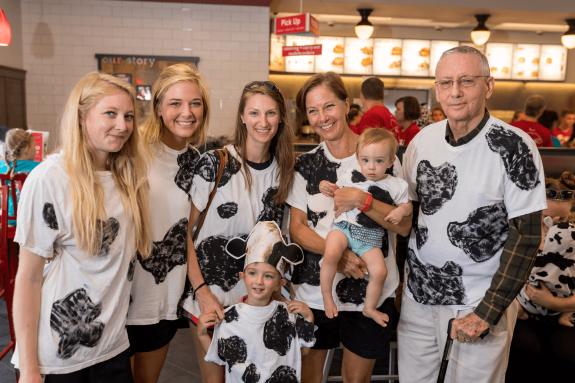
(Source)
Is it ridiculous? Definitely.
Does the company give away a ton of free food that day? For sure.
Is it all worth it? You bet:
Year after year, the additional foot traffic from new and current customers alike on that one day drastically improves the company’s average daily revenue.
If Chick-fil-A can generate WOM by asking their customers to dress as cows, the sky’s the limit for how you can get your customer base to do so.
How to email your customers asking for referrals
When sending emails to your customers asking for referrals, you want to make sure that you get a few things right. Otherwise, the email may be ignored and deleted without even being read. No one wants that.

1. Create a great subject line
First and foremost, focus on creating a great subject line. Answer their burning question of “What’s in it for me?” in the subject line. This will increase your open rate.
- Be clear, not clever. Get to the point quickly
- Be personal. Speak directly to your customers as though they’re friends.
2. Keep it simple
Keep the email simple with an impossible to ignore the call to action. No one has time for lengthy explanations of why to give referrals. They likely won’t read them either. But make sure that your call to action is clear and easy to understand.
“Give $20, Get $20!”
This works well. Simple and easy to understand.
3. Emphasize the rewards
Make sure that you emphasize the motivation for referring the friends. This can be done with a picture as we see in the Oola Tea example.

The photo emphasizes the benefit of both the friend and the advocate. Oola Tea entices their customers to create referrals by offering them $10 when their friends make a purchase. This turns their loyal customers into part of their marketing team.
Referral programs are most effective when there is a benefit for the referrer and the friend.
You can include the referral as a part of your loyalty program or run in separately, but make sure to promote the programs throughout several touchpoints. This is what a lot of marketing software offer (Sidenote: Check out Email Vendor Selection’s Hubspot alternatives post for this).
4. Include additional conditions
Finally, you’ll want to include any additional details or steps for the reader to take. For example, your friend has to make a purchase for you to receive the referral reward.
Email marketing is extremely helpful when it comes to referral marketing. Often people are very busy and need multiple reminders before making a referral. An email marketing campaign focused on triggering referrals can gently remind your customers at regular intervals that they’ll benefit from referring friends.
How to set up the right referral structure
There is no perfect referral structure for every business. Figuring out the right referral structure will take some time and getting to know your customers. Discover what motivates them.
There are some best practices for setting up referral rewards. For example, if the items that you sell are usually one time purchases, it is better to reward the referrers with cash. Some examples would be mattresses or computers.
Follow these steps as you set up your referral rewards:
- It is best to offer at least a ten percent discount as a bonus. Less than that may not motivate anyone to refer their friends and family.
- Custom rewards can also be given for referrals and should be used if that is what your customers respond to best.
- Test out different rewards.
- Remind customers regularly to refer their friends.
How to motivate customers to generate brand-related content
Customers will trust their peers 83 percent more than they trust branded advertisements. Therefore, it is essential that you focus on getting their peers talking about your brand.
This is actually not as difficult as it may sound. Sharing purchases on social media is becoming commonplace. Most people have smartphones with cameras to take pictures.
Many people take to social media and ask their friends for recommendations before making a purchase.
What can you do to inspire your customers to create user-generated content?
- Start sharing some examples and encourage them in social media posts to do the same.
- Create a social media contest for your customers.
- Create catchy hashtags for customers to discover your posts.
- Include brand images with your photos.
- Give away loyalty points for customers who create content for you.
Social media contest case study: McCormick’s online cookoff
A good example is when McCormick wanted to launch a new line of Filipino spices. They knew they were entering a crowded market. Through research, they identified an untapped market of Filipino-Canadians.

(Image source: Life on Manitoulin)
McCormick targeted the younger generation of Filipinos with a technologically savvy online cook-off contest. They encouraged customers to share their best Filipino recipes with photos.
Contestants submitted recipes and photos that were shared in an online gallery, and viewers voted for their favorites. This created a nice social media buzz around McCormick’s new Filipino spice blends.

(Image source: Pinterest)
The campaign created over 25,000 views and 20,000 votes within 3 months. It increased McCormick’s sales by 37 percent from the previous year.
When brands inspire their customers to create content and form online communities, they can see an average of 20 percent more visits to their sites according to Wendell Landsford in his Marketingland article. On average, they’ll receive 25 percent more email subscribers and a 50% lift in social engagements.
How to set up your own online contests
Setting up an online contest is easier than you might think, and here’s a step-by-step guide to prove it.

1. Choose a contest software
First of all, select a software to run the contest. Strutta and Rafflecopter allow you to run online contests with minimal effort. Contest software can facilitate the collection of entries and will integrate with Facebook and other social networks. They can also randomly select winners for you.
2. Pick a reward or prize
You’ll want to discover what motivates your customers. There are a few ways to do this:
- Create an online poll and share it on social media. You can use Facebook Polls.
- Select your most popular product to give away.
- Give away a gift card or cash prize.
3. Set the rules
After you have a giveaway for the contest, you need to create the rules. When you set up your online contest, ensure that it is engaging. Some great rules for the contest to ensure engagement could be:
- Share a photo of yourself with the product.
- Create a video contest.
- Like the contest page.
- Share the contest with your friends and family.
Make sure you read up on the rules for contests. Each social media site has different rules and you don’t want to have your contest shut down because you didn’t follow them.
4. Choose a winner
Finally, select a winner. There are a number of different ways to determine winners of online contests.
- Use a survey and have people vote on the best photo.
- Randomly select the photo.
- Select the post with the most engagement.
5. Publicize the results
Announce the winner online. Make sure that you share the announcement on all the social media platforms. Thank everyone who entered the contest.
When the contest is over, run analytics and determine if you met your goals. Did you generate buzz? What worked well? What didn’t work? Where can you improve next time?
Engaging contests make your brand more fun and exciting. People will come back, again and again, to see what type of content their friends created.
It’s time to turn customers into brand ambassadors
Customer acquisition is one thing, but customer retention, and better yet, customer loyalty, is a whole new level of success.
Contests, in particular, are a great way to bolster engagement and customer satisfaction, both of which instill brand loyalty. Similarly, referrals are a great way to spread the love and build a marketing team made of your customers.
Finally, encouraging user-generated will help your customers become more engaged with your brand, leading to further contest participation and more referrals.



